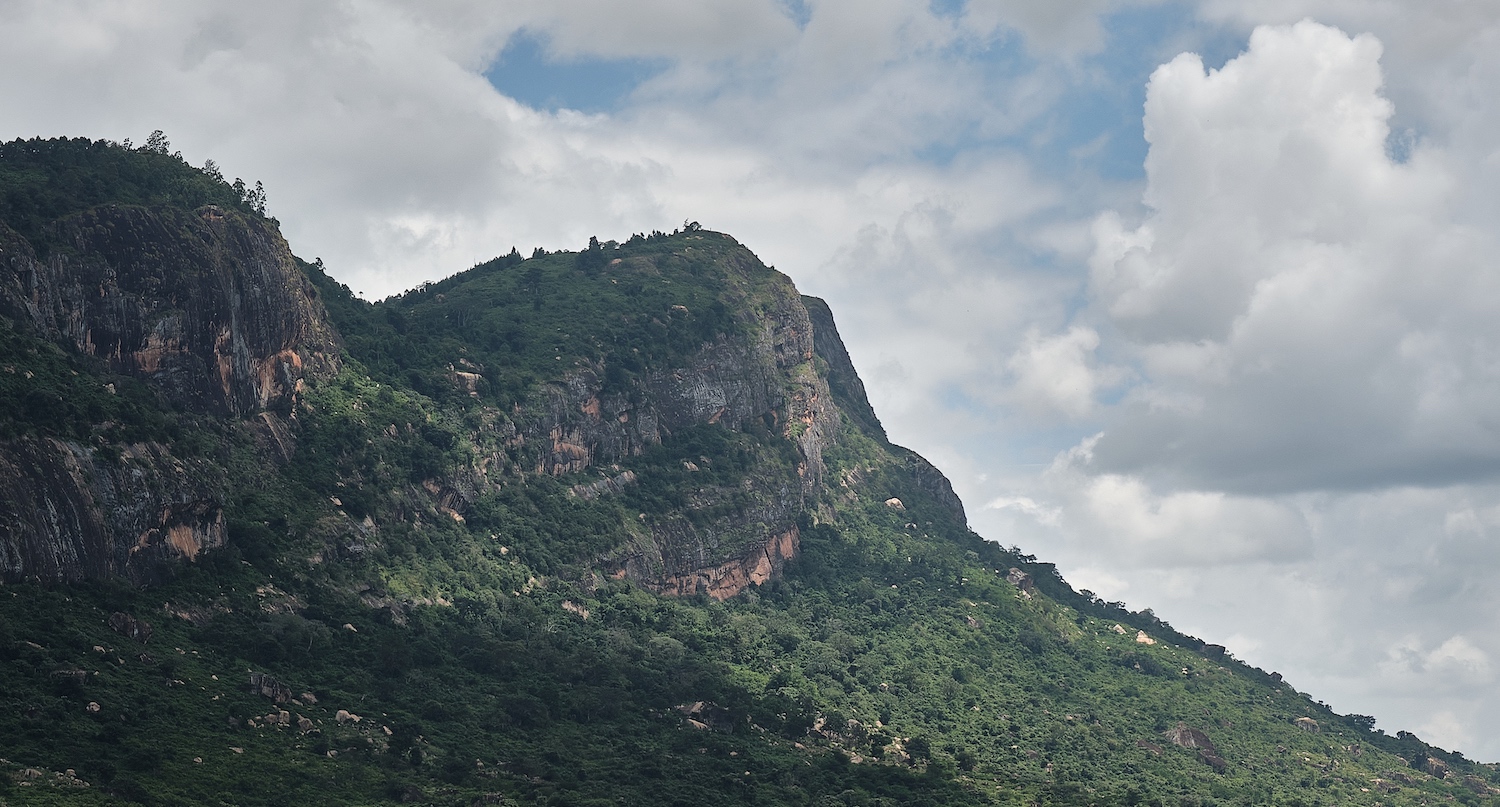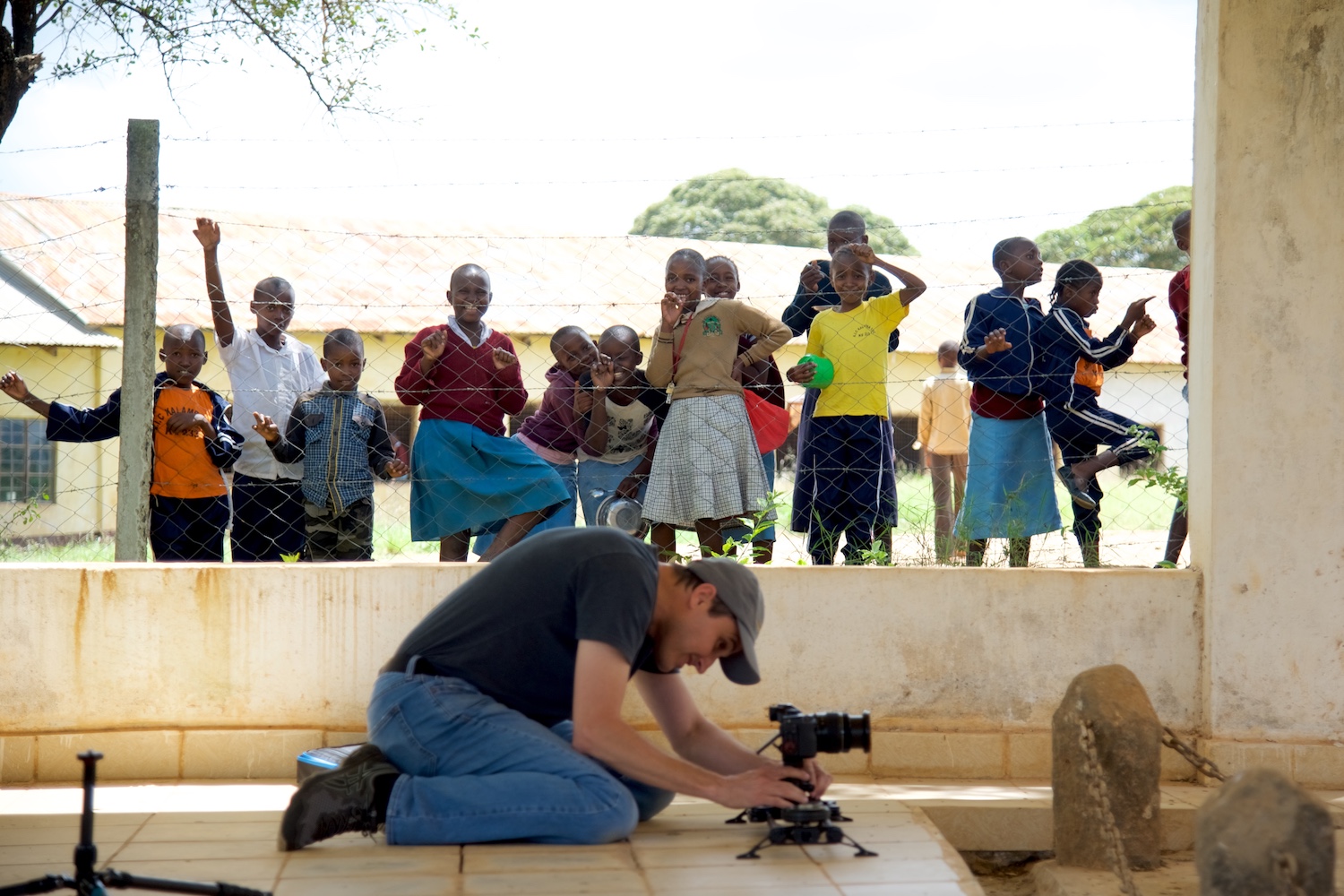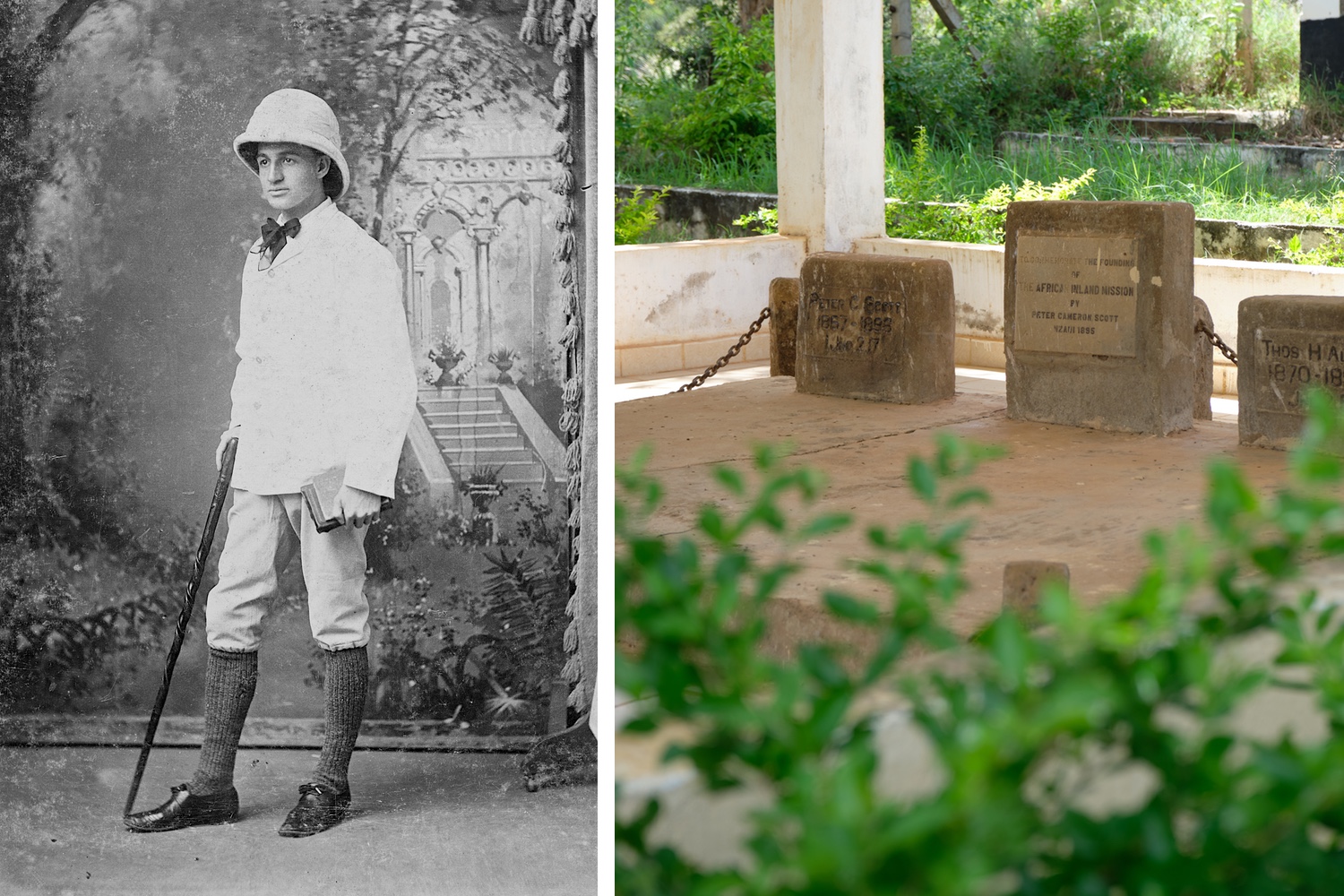
Gateway
My journey to Kalamba started on Google Earth. While planning a recent trip to Africa I thought I would add a quick visit to the place where it all started – a small town in eastern Kenya where, 125 years ago, AIM’s intrepid founder briefly labored, died, and was buried. At the time, all I had to go on was a village name and some old photos of a historic church. The small church was known for its odd architecture, which was the key to pinpointing it in a satellite image. I traced the dirt roads backwards to the tarmac and then to Nairobi.
My journey, actually, began well before this little bit of detective work. The year prior I was on a small, personal mission to piece together the life of Peter Cameron Scott. I had long held an unexplored curiosity about our young founder. You might say that I was “fan”. But there was precious little information on hand – just a few paragraphs and a couple of photos that I knew of. So I scoured the library at the office and started into the archive of AIM’s magazine. The first few issues contain reprinted portions of Peter’s diary. I carefully unfolded the yellowing, brittle pages and scanned them.
I then turned to the web and found a small trove of pamphlets, booklets, and academic papers that mentioned him in some form, as well as a few books from the Library of Congress digital archive. One that I couldn’t find I bought from an old bookshop via eBay. Even with all of this I didn’t find what I had hoped to. It seems Peter wrote very little, and he wasn’t famous or influential enough to engender a lengthy biography. His Wikipedia page is a mere ten sentences. It may be a short story, but his life was nonetheless storied.
Peter was twenty-eight years old in 1895 when he led a small band of fellow missionaries on foot from the port of Mombasa in what was then British East Africa, toward the yet unreached regions of the continent. The years leading up to this were not without drama. He had been seriously injured as a child. Sickly as a young adult. Wrestled God through the death of a sister. Was left despondent and alone as he buried a brother with his own hands in the Congo. Fell gravely ill yet again. Later, at a critical juncture in his life, Peter stood torn between a path to fame and fortune and a call to obedience and sacrifice. He lived up to his name in some ways. Like the Peter who once walked in Jesus’ shadow, he was passionate and impulsive: At one moment sold out to God’s service, and the next, running headstrong the other way. When God finally got a firm hold on his heart and his faith matured, he became an unstoppable combination of a surrendered life and a singular vision.
Peter felt compelled to bring the gospel where it had never been. For Africa, this meant trekking inland. The road ahead was daunting particularly because there was no road. They traveled in a massive caravan: 8 missionaries, 40 camels, and 300 porters. Days turned to weeks. They were attacked by wild animals, threatened by warring tribes, running low on food and water; at every turn surveying the landscape and struggling to communicate with the people they encountered.
As the party headed westward, a massive ridge-line revealed itself faintly on the horizon. They set the unknown landmark in their sights, deeming it sufficiently “inland” to serve as their first destination. They would learn later that the mountain, called Nzawi, was central to the local folklore. It was here, the Kamba people believed, that the creator placed the first man (Mundu) and his wife (Kiveti) and all their wealth and gave them the Kikamba language. This “place of beginnings” it seems, was also God’s intended place to start a new work for the gospel in Africa. Peter and his caravan reached Nzawi on December 12th, 1895, after one month and 250 kilometers of arduous foot travel. Peter declared the great Nzawi peak the “gateway to central Africa.”
Some 125 years later, I headed eastward from Nairobi toward the very same landmark. Our journey looked different: Instead of a caravan of camels and footmen, I traveled with fellow AIMers, Josh and Ryan, in a Land Rover. Our trip took three hours and I sipped coffee much of the way (Ryan spilled his all over his trousers, but then again, he was fairly new to both Land Rovers and Josh’s driving). Not trusting my initial Google Earth navigation scheme, I connected with another missionary with more firsthand knowledge of the place. Stephanie emailed us proper driving directions, including a description of a rather “dodgy” river crossing. I admit I had some reservations about our little expedition. Would the roads be worse than anticipated? Would the destination be welcoming? Would the message I was invited to preach that Sunday morning echo through an empty church? Where would we spend the night? All of these concerns sounded ridiculous, however, when compared to Peter’s journey log.
“We marched hard until 9:30pm, keeping along the eastern slope of the Ndara hills, reaching Voi camp with blistered feet, the result of badly fitting shoes.”
“About 2:30am a lion got into camp and tore down a little tent in which slept two of the porters, and ran off with it into the bush. By the size of the print of his paws he must have been a monster.”
“This is the place and time when all our Christian patience and fortitude is put to the test, and it brings out what is really in a man.”
For us, all that was really put to the test was our ability to follow directions. Today, a small town called Kalamba sits at the foot of the Nzawi peak, but the mountain I imagine hasn’t changed much at all. We found the Africa Inland Church (AIC) compound with its colorful gate proudly establishing the place as the origin of the denomination. Kioko, the AIC District Council Chairman, and Stanley, the local pastor, received us warmly, as genuine brothers in Christ. We shared a meal and were treated to a VIP tour of the historic site. There was a new library and a museum still to be filled (a life-size wood carving of Peter Scott is reportedly on order). In the center of the small complex was Peter’s gravesite, a dull concrete slab under a well-kept open-air mausoleum. A simple headstone displayed a scripture reference: “1 Jno 2:17”, “The world and its desires pass away, but whoever does the will of God lives forever.”
Ryan, Josh, and I gathered some photos and video clips, and after we were done, I stole a little time alone at the grave. There I took a moment to contemplate a kindred soul. I was once twenty-eight and a missionary in East Africa. Barreling over the landscape in an airplane – over punishing miles that Peter trod in nineteenth-century boots – I was a different sort of missionary as an AIM pilot. Or was I? Apart from the old newspaper articles and church pamphlets that boast of a man of uncommon courage, I remember reading of the boy who was at once weak, uncertain, stumbling, but always trusting. Peter’s studio portrait fit the adventurous stereotype of the day, but under a pith helmet that always seemed too big for his face, I see humility and determination in his eyes. I see a young man who knows his sufficiency is found in Christ alone, and a man so compelled by God’s love he was ready to risk much for the gospel.
I touched the headstone and whispered, “well done Peter”, before returning to join the others.
For most of 1896, Peter and his team made Nzawi a home base for their many excursions into the surrounding areas, establishing other “mission stations” as God led. But they encountered monumental opposition. Toward the end of that year, he wrote this in his diary:
“Since first leaving Mombasa, I have walked 2,600 miles, and have seen many strange and sorrowful sights. We have had times of trial, also times of blessing; times of sorrow and times of joy. Patience has been put to the test, but God has answered prayer.”
We caught a glimpse of what they were up against on a visit to a Kamba home to interview the oldest member of the local church. Jonathan is 95 years old (give or take, no one really knows). Blind and struggling to remember, he turned his face skyward as he told us of when he was a young man and first put his faith in Christ – how he was threatened by his family, forced to leave home, and taken in by a stranger. The community hated him and plotted to kill him. “There used to be so much fighting here, bad things, darkness,” he recalled. Beside him sat his wife Alice – a picture of incredible peace and contagious joy that defied all the odds of what should have been the story of the Kamba people.
“Men, beasts, fever, the very prince of darkness himself, all sought to shut our friends out of the Nzawi valley. But God, who ever proves himself faithful to those who will press forward in His name, did not fail them.” [From the book, Life out of Death]
When the missionaries wanted to build their first church here, the community gave them the worst plot of land they could spare – a giant, awkward rock near to the shrines of their traditional spirits. They figured this would surely spell doom for the endeavor. When Kioko showed us around the church rebuilt on that site in 1932, he mused about the “rock that the builders rejected.” Destined to fail? Quite the opposite rather. Like Jonathan, the church not only survived but thrived.
The church in use today is a much larger building just steps away from the historic brick building on the rock; and on Sunday morning, we joined the congregation of AIC Kalamba for their Kikamba service. I shared a sermon on “trust” that wove in the colorful thread of Peter’s life and death. As pastor Stanley translated, I challenged the church to think about what it might mean to trust God enough to carry the gospel to an unreached people. Sharing from the pulpit – from this particular pulpit – on a packed Sunday morning was a special treat for me, a kind of milestone in my two-decades journey in missions. But the highlight of the morning, of the whole trip actually, was joining in worship. From a small community that filled a large church in the shadow of the Nzawi peak came thundering praise and celebration as I have seldom experienced. Walls shook. Hands wove. People danced.
As I stood near the front with Josh and Ryan, we exchanged smiles and took it all in. Enveloped in the swell, I closed my eyes and followed the roar and rumble out the doors and up the hill to the place where Peter and those first missionaries settled so many years ago. I remembered the story of Peter dying there, only a year into what he expected was a life calling. Having given his all and still so far from seeing fruit, he breathed his last. I wondered if he questioned God’s design; And if he ever imagined those hills reverberating with praise as they did today. As they do every Sunday. I wondered if he imagined what would follow.
A month after his death, Peter’s sister wrote this:
“So now the first stepping stone has been laid inside the gateway. The grain of wheat has fallen to the ground and has been watered with tears and prayers.”
I suspect we give more thought to Peter’s legacy than he ever did. To us, he may have been a pioneer, a leader, and the founder of a mission agency. But he was simply a man who served Christ with a kind of reckless obedience that allowed God to use him for something significant while still unseen. As a self-described fan of the intrepid Peter Cameron Scott, these are the lessons I gleaned from my exhaustive research and our impromptu, dusty-road pilgrimage to the place where it all began: Abide deeply in Christ. Go boldly. Be driven by love. Stay humble. And embrace the fact that success will be defined by God, not us. That Peter’s life can remind us of these essential, timeless principles as we respond to the Great Commission in the 21st Century is perhaps his greatest legacy.
Next time you’re in Kenya I encourage you to make a visit to Kalamba. The people are warm and welcoming, and the terraced hills beautiful. Stay for a Sunday. Close your eyes in the midst of unbridled song and imagine the distant hopes of the brave men and woman who first ventured there with the gospel. Be moved by the weight of this reality: That you can experience the fruit of God’s long and patient work – the fruit of joy and praise and light that bears the remnants of much sacrifice, surrender, and expectation. It is a testament to God’s ways: unfolding over the long view, like a mountain far in the distance to which the foot-weary traveler never seems any closer than he did the day before. But to God it’s “just there”. 125 years is a blink of an eye. The Kamba are reached. And the Basoga and the Azande. From this gateway, Christ-centered churches have spread even further than Peter hoped or imagined: From Mombasa to Lake Chad, across the Sahara, and into secret home gatherings in North Africa. Peter never had a chance to see all this. But one day he will. [Rev. 7:9]



